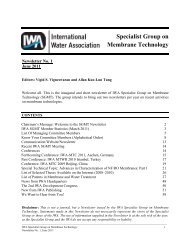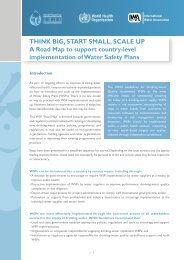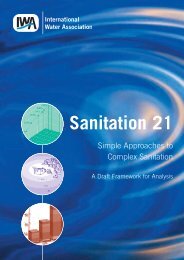Specialist Group on ANAEROBIC DIGESTION Newsletter - IWA
Specialist Group on ANAEROBIC DIGESTION Newsletter - IWA
Specialist Group on ANAEROBIC DIGESTION Newsletter - IWA
Create successful ePaper yourself
Turn your PDF publications into a flip-book with our unique Google optimized e-Paper software.
Development of High-Rate Anaerobic Granular Sludge Bed Process for Low<br />
Strength Wastewater Treatment at Low Temperature<br />
by Wilasinee Yoochatchaval (wilasinee.y@nies.go.jp)<br />
New PhD C<strong>on</strong>tact:<br />
Post doctoral researcher, Water and Soil Envir<strong>on</strong>ment divisi<strong>on</strong>,<br />
Nati<strong>on</strong>al Institute for Envir<strong>on</strong>mental Studies, 16-2 Onogawa,<br />
Tsukuba, Ibaraki, Japan 305-8506<br />
Email: wilasinee.y@nies.go.jp, wilasinee_y@hotmail.com<br />
Supervisors:<br />
Dr. Kazuaki Syutsubo, Senior Researcher of Nati<strong>on</strong>al Institute for Envir<strong>on</strong>mental<br />
Studies, Japan<br />
Dr. Takashi Yamaguchi, Associate Professor of Nagaoka University of Technology,<br />
Japan<br />
Dr. Hideki Harada, Professor of Tohoku University, Japan<br />
Abstract:<br />
In this study, the anaerobic granular sludge process and its operati<strong>on</strong> mode were established for efficienttreatment<br />
of the low strength wastewater at low temperature. First of all, the feasibility of an expanded granular<br />
sludge bed (EGSB) reactor for low strength wastewater with 0.6-0.8 g COD/L was tested at 20°C. In this<br />
process, methanogenic granular sludge was used as seed and recirculati<strong>on</strong> of effluent was made to fluidize the<br />
sludge bed. As a result, sludge retenti<strong>on</strong> in this process was very well (over 40 days). C<strong>on</strong>sequently, this process<br />
was possible to achieve high rate treatment of low strength wastewater at hydraulic retenti<strong>on</strong> time of 1.5 h with<br />
COD loading rate of 12.8 kg COD/m 3 /day.<br />
The influence of decreasing in the temperature and the organic c<strong>on</strong>centrati<strong>on</strong> of the wastewater was<br />
evaluated in lab-scale EGSB reactor. The reactor exhibited sufficient COD removal efficiency until 10°C<br />
operati<strong>on</strong> due to the good-microbial adaptati<strong>on</strong> of granular sludge at low temperature. The significant increase<br />
of hydrogen-fed methanogenic activity between test temperatures of 15°C and 20°C was observed. At this time,<br />
proliferati<strong>on</strong> of psychrotolerant methanogen (hydrogen utilizing Methanospirillum spp.) in the retained sludge<br />
was c<strong>on</strong>firmed. On the other hand, decrease of organic c<strong>on</strong>centrati<strong>on</strong> of wastewater (from 0.8 to 0.4 gCOD/L)<br />
has caused the deteriorati<strong>on</strong> of organic removal efficiency and physical property of retained sludge due to the<br />
inactivati<strong>on</strong> of anaerobic bacteria. To solve this problem, new operati<strong>on</strong>al technology was proposed. C<strong>on</strong>trol of<br />
ORP of influent and intermittent the effluent recirculati<strong>on</strong> are possible to active the microbial activity of<br />
methanogens in the retained sludge.<br />
To clarify the effect of sucrose c<strong>on</strong>tent of fed-wastewater <strong>on</strong> the physico-microbial characteristics of<br />
granular sludge, we operated two reactors at 20°C by sucrose based wastewater (sucrose, 90% of COD) and<br />
volatile fatty acid based wastewater (sucrose, 0% of COD). Sucrose founded much negatives effects <strong>on</strong> the<br />
granular sludge physical properties and microbial properties (bulking and wash out of retained sludge due to the<br />
overgrowth of acidogens) at low temperature c<strong>on</strong>diti<strong>on</strong>.<br />
<strong>IWA</strong> <str<strong>on</strong>g>Specialist</str<strong>on</strong>g> <str<strong>on</strong>g>Group</str<strong>on</strong>g> <strong>on</strong> Anaerobic Digesti<strong>on</strong><br />
28 June 2009 <strong>Newsletter</strong>

















